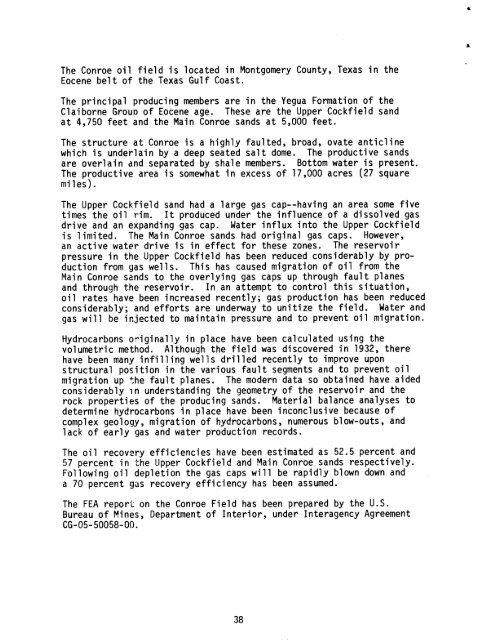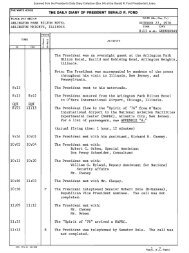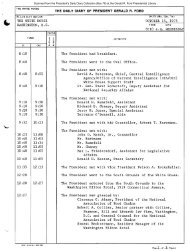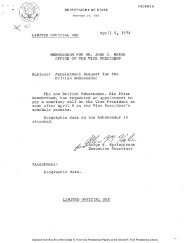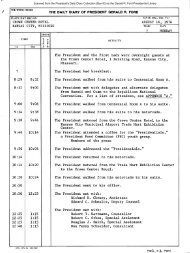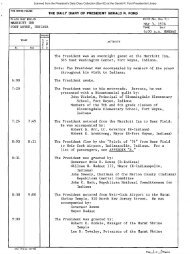October 31, 1975 - Gerald R. Ford Presidential Library and Museum
October 31, 1975 - Gerald R. Ford Presidential Library and Museum
October 31, 1975 - Gerald R. Ford Presidential Library and Museum
You also want an ePaper? Increase the reach of your titles
YUMPU automatically turns print PDFs into web optimized ePapers that Google loves.
The Conroe oil field is located in Montgomery County, Texas in the<br />
Eocene belt of the Texas Gulf Coast.<br />
The principal producing members are in the Yegua Formation of the<br />
Claiborne GrouD of Eocene age. These are the Upper Cockfield s<strong>and</strong><br />
at 4,750 feet <strong>and</strong> the Main Conroe s<strong>and</strong>s at 5,000 feet.<br />
The structure at Conroe is a highly faulted, broad, ovate anticline<br />
which is underlain by a deep seated salt dome. The productive s<strong>and</strong>s<br />
are overlain dnd separated by shale members. Bottom water is present.<br />
The productive area is somewhat in excess of 17,000 acres (27 square<br />
miles).<br />
The Upper Cockfield s<strong>and</strong> had a large gas cap--having an area some five<br />
times the oil rim. It produced under the influence of a dissolved gas<br />
drive <strong>and</strong> an exp<strong>and</strong>ing gas cap. Water influx into the Upper Cockfield<br />
is limited. The Main Conroe s<strong>and</strong>s had original gas caps. However,<br />
an active water drive is in effect for these zones. The reservoir<br />
pressure in the Upper Cockfield has been reduced considerably by production<br />
from gas wells. This has caused migration of oil from the<br />
Main Conroe s<strong>and</strong>s to the overlying gas caps up through fault planes<br />
<strong>and</strong> through the reservoir. In an attempt to control this situation,<br />
oil rates have been increased recently; gas production has been reduced<br />
considerably; <strong>and</strong> efforts are underway to unitize the field. Water <strong>and</strong><br />
gas will be injected to maintain pressure <strong>and</strong> to prevent oil migration.<br />
Hydrocarbons originally in place have been calculated using the<br />
volumetric method. Although the field was discovered in 1932, there<br />
have been many infilling wells drilled recently to improve upon<br />
structural position in the various fault segments <strong>and</strong> to prevent oil<br />
migration up the fault planes. The modern data so obtained have aided<br />
considerably 1n underst<strong>and</strong>ing the geometry of the reservoir <strong>and</strong> the<br />
rock properties of the producing s<strong>and</strong>s. Material balance analyses to<br />
determine hydrocarbons in place have been inconclusive because of<br />
complex geology, migration of hydrocarbons, numerous blow-outs, <strong>and</strong><br />
lack of early gas <strong>and</strong> water production records.<br />
The oil recovery efficiencies have been estimated as 52.5 percent <strong>and</strong><br />
57 percent in the Upper Cockfield <strong>and</strong> Main Conroe s<strong>and</strong>s respectively.<br />
Following oil depletion the gas caps will be rapidly blown down <strong>and</strong><br />
a 70 percent gas recovery efficiency has been assumed.<br />
The FEA report on the Conroe Field has been prepared by the U.S.<br />
Bureau of Mines, Department of Interior, under Interagency Agreement<br />
CG-05-50058-00.<br />
38


